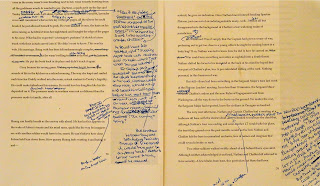How To Revise for Discovery
 |
| I’ve been doing a bit of inspired revision of my own, lately. |
It’s a whirlwind of finishing touches and final drafts, of performances and huge crowds. Summer Arts Camp comes to a close this weekend and I’m so thrilled about all that my students have accomplished. We spend roughly one week studying poetry, with an emphasis on these techniques: repetition, concrete imagery, simile, metaphor, lists, line/stanza breaks, punctuation, and sensory detail. Then we study flash fiction, where I teach my students about what I call “The 5 S’s,” “The 4 Powers,” flash forward, flash back, and “pressing pause.” Of course, when they begin writing flash, they already have the foundation of poetry, so they work techniques such as concrete imagery and repetition into their prose. It’s very exciting to see.
As a final step, I discuss what I call “inspired revision” with my students. I like to start out by asking them what they have been taught about revision. Inevitably, they tell me that revision is the same thing as correction. That “revising” is what you do right before your final draft and that usually you need the teacher to mark your paper with a red pen first, and then you can revise. They also tell me that sometimes revision is the part that you have to do alone, or that you can ask a partner to help you with. Always, they say that revision has to do with “fixing” or “finishing.” I tell them what they have described is just one understanding of the word “revision,” and that in the writing world we actually call that process of “editing.”
Then I ask them if they ever thought of revision as discovery. They always shake their heads, “No.” When I ask them if they feel excited about revision, I see more heads shaking. Revision is not something we’ve taught our young writers to enjoy. In my class, I like to call revision “inspired revision” because it is a re-visioning of the work, not a simple “correcting.” True revision does not yield the same “final draft” for everyone in the room, even if they were given the same story to revise and the same red pen marks. Inspired revision has more to do with discovery and unearthing what a sentence (or line) is trying to say. By way of example, we discuss a few sample sentences from their writing and talk about the different ways we might revise (which sometimes means rewrite) them, and how each of those different ways might work. There’s no “right” or “wrong” way to do it. It’s a personal, organic process that involves thinking, scribbling, walking, pondering, crossing out, looking things up, discovering, and deciding.
Much of this is articulated brilliantly by Verlyn Klinkenborg in his fantastic book about writing, called A Few Short Sentences About Writing. (Here’s a previous post on this text, if you’d like to see excerpts.) It’s a dense text for teens, however, so I only share a few quotes with them as we discuss inspired revision. Then I tell them that the process is sort of like wearing 3-D glasses and having X-Ray vision at the same time. Instantly, their faces perk up. This helps them get excited about re-visioning their stories so that they feel more alive, full, and complete (the 3-D part). When it comes to X-Ray vision, we talk about how a sentence can be a hint to the sentence you really meant to write, but the only way to see that is to re-vision it for discovery…not for “correctness.”

